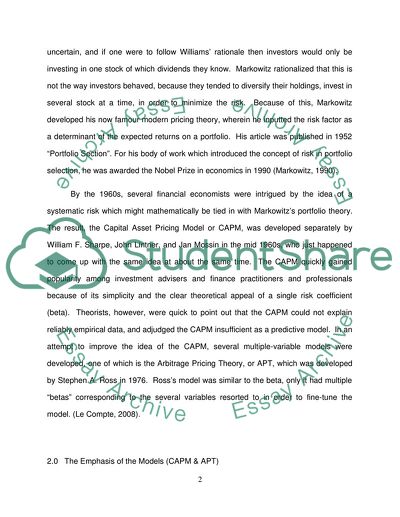Cite this document
(Capital Asset Pricing Model & Arbitrage Pricing Theory Model Assignment - 1, n.d.)
Capital Asset Pricing Model & Arbitrage Pricing Theory Model Assignment - 1. Retrieved from https://studentshare.org/macro-microeconomics/1730895-critically-analyse-the-capital-asset-pricing-model-capm-and-arbitrage-pricing-theory-apt-modelsyour-analysis-may-include-drawing-simlarities-difference-and-weakness-of-the-models-in-relation-to-real-life-practical-situations-mba-finance-subject
Capital Asset Pricing Model & Arbitrage Pricing Theory Model Assignment - 1. Retrieved from https://studentshare.org/macro-microeconomics/1730895-critically-analyse-the-capital-asset-pricing-model-capm-and-arbitrage-pricing-theory-apt-modelsyour-analysis-may-include-drawing-simlarities-difference-and-weakness-of-the-models-in-relation-to-real-life-practical-situations-mba-finance-subject
(Capital Asset Pricing Model & Arbitrage Pricing Theory Model Assignment - 1)
Capital Asset Pricing Model & Arbitrage Pricing Theory Model Assignment - 1. https://studentshare.org/macro-microeconomics/1730895-critically-analyse-the-capital-asset-pricing-model-capm-and-arbitrage-pricing-theory-apt-modelsyour-analysis-may-include-drawing-simlarities-difference-and-weakness-of-the-models-in-relation-to-real-life-practical-situations-mba-finance-subject.
Capital Asset Pricing Model & Arbitrage Pricing Theory Model Assignment - 1. https://studentshare.org/macro-microeconomics/1730895-critically-analyse-the-capital-asset-pricing-model-capm-and-arbitrage-pricing-theory-apt-modelsyour-analysis-may-include-drawing-simlarities-difference-and-weakness-of-the-models-in-relation-to-real-life-practical-situations-mba-finance-subject.
“Capital Asset Pricing Model & Arbitrage Pricing Theory Model Assignment - 1”, n.d. https://studentshare.org/macro-microeconomics/1730895-critically-analyse-the-capital-asset-pricing-model-capm-and-arbitrage-pricing-theory-apt-modelsyour-analysis-may-include-drawing-simlarities-difference-and-weakness-of-the-models-in-relation-to-real-life-practical-situations-mba-finance-subject.


